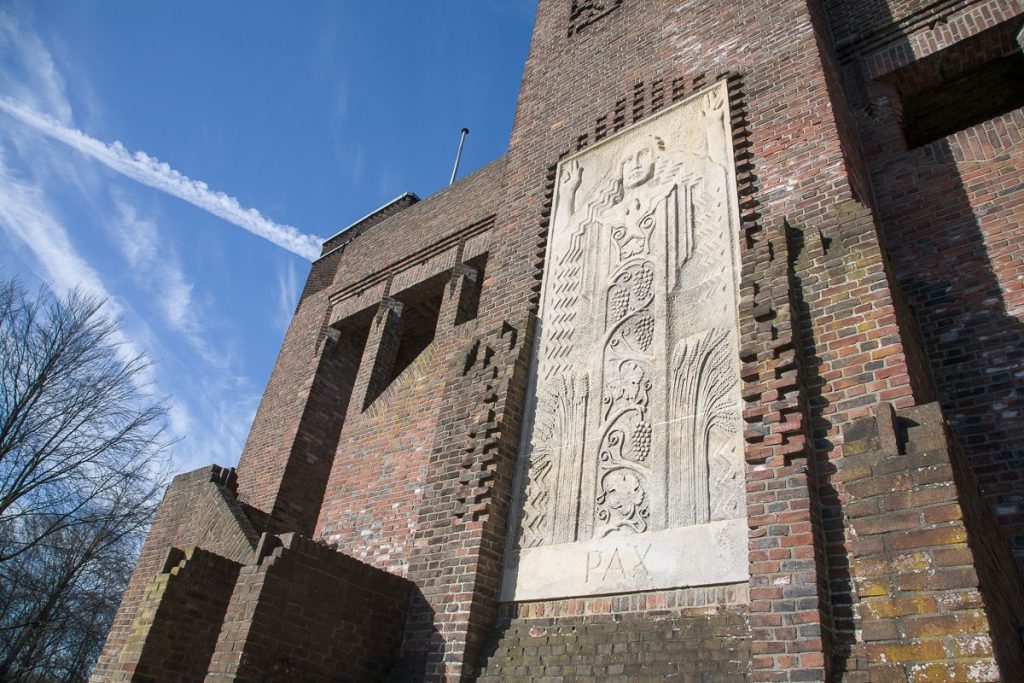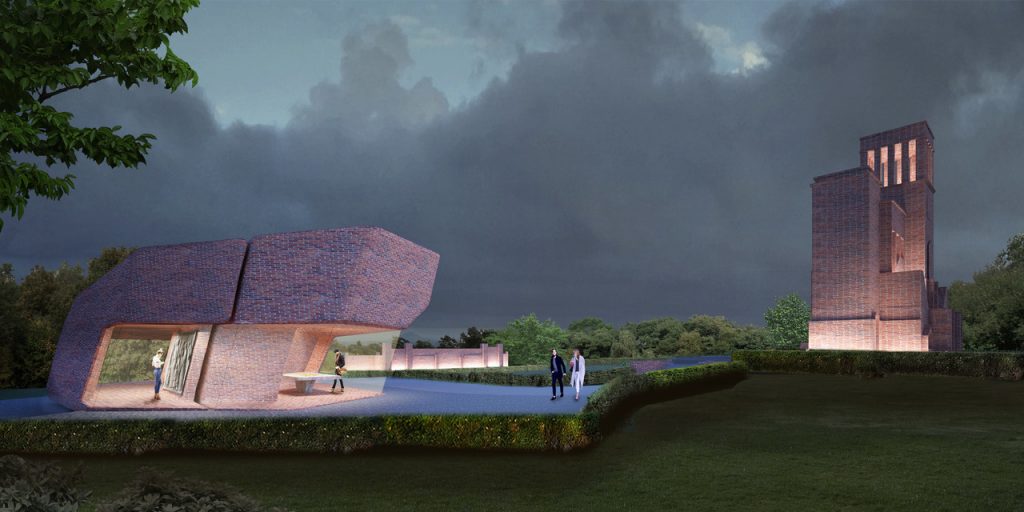Het Belgenmonument in Amersfoort is het grootste oorlogsmonument van Nederland. Honderd jaar geleden werd gestart met de bouw. Het is onlangs gerestaureerd, maar heeft geen functie meer. Er wordt gezocht naar nieuwe zingeving.
Architectuurcentrum FASadE schreef hiervoor een ontwerpwedstrijd uit. Doel: het Belgenmonument een hernieuwde betekenis te geven als memorial maar ook als symbool voor de opvang van hedendaagse ontheemden.
De jury onder leiding van de (Belgische) NRC-hoofdredacteur Peter Vandermeersch koos als winnend ontwerp ‘Museum voor Gastvrijheid’, van de in Londen gevestigde Nederlandse architect Matthijs la Roi. Of het ontwerp ook daadwerkelijk wordt uitgevoerd is de vraag. Voorlopig ontbreken de financiële middelen.
Lammetje
Monumenten uit de Eerste Wereldoorlog kunnen grote indruk maken. Wie bijvoorbeeld een bezoek heeft gebracht aan het In Flanders Fields Museum in Ieper kan daar over meepraten. Het is een huiveringwekkende ervaring die voor altijd in het geheugen staat gegrift.
Vergeleken met het In Flanders Fields Museum is het Belgenmonument een lammetje in de wei. Geen ontploffende granaten, krijsende soldaten, gasaanvallen of andere nietsontziende ellende. Integendeel. Een mevrouw laat haar hondje uit. Een mountainbiker zwoegt voorbij. Een meneer met een wandelstok geniet op een bankje vredig van de herfstzon.
De herinneringen aan de Eerste Wereldoorlog en de Belgische vluchtelingen die het monument bouwden, konden op deze mooie herfstmiddag niet verder weg zijn.
Neutraliteit
Tijdens de Eerste Wereldoorlog (door de Belgen zo treffend De Grote Oorlog genoemd) vluchtten bijna een miljoen Belgische burgers en soldaten naar Nederland. De soldaten werden opgesloten in interneringskampen, verspreid door het land. Een neutraal land als Nederland moest ervoor zorgen dat ze niet meer deel konden nemen aan de strijd (bijvoorbeeld door naar Engeland te gaan). De Nederlandse regering kweet zich nauwgezet van deze taak, uit angst alsnog bij de oorlog te worden betrokken.
De soldaten werden in Amersfoort opgesloten in een veel te kleine kazerne. Het sanitair was ontoereikend, ze verveelden zich en mochten het kazerneterrein niet verlaten. Dat leidde tot incidenten, met als dieptepunt een schietpartij vanwege een vermeende ontsnappingspoging waarbij acht Belgen werden doodgeschoten.
Om wat aan de verveling te doen werden er werkscholen opgericht. Later mochten de geïnterneerden ook buiten de kampen gaan wonen en zelfs werken, natuurlijk alleen als dit niet ten koste van Nederlandse banen ging. In 1916 boden de werkscholen aan een monument te bouwen, ‘als dankbetuiging jegens de Nederlandse overheid en de natie, voor al hetgeen gedaan is geworden tot welzijn der geïnterneerden en hunnen gezinnen’.
Als locatie werd gekozen voor de top van de (toen nog) kale Amersfoortse berg. Een plek die een weids uitzicht bood, tot Utrecht en de Zuiderzee aan toe. Het monument zou voor iedereen en al van verre te zien zijn.

Evenwicht
De Belgische architect Huib Hoste was vanwege de oorlog naar Nederland gevlucht. In Amsterdam maakte hij kennis met Berlage, vooral bekend door zijn Beurs op het Damrak. Een gebouw met een strenge rationalistische vormgeving en veel beeldhouwwerk. Ondertussen werd op de Prins Hendrikkade het Scheepvaarthuis gebouwd: het beginpunt van de Amsterdamse school. De architecten (waaronder Joan van der Meij en Piet Kramer) maakten decoratief gebruik van baksteen, als reactie op de sobere stijl van Berlage. Ook bij hen speelde beeldhouwwerk een grote rol. Hoste wilde maar al te graag zijn indrukken verwerken tot een nieuw bouwwerk. Die kans kwam toen hij voor het Belgenmonument werd gevraagd.
Hij koos voor een ontwerp met een hoofdgebouw en een lager gelegen muur. Het geheel werd uit bouwsteen opgetrokken en moest evenwicht uitstralen, als tegenwicht tegen de chaos van de oorlog. Op mooie zomeravonden zou de ondergaande zon de voorkant verlichten. Op die manier werden de twee doelstellingen van het monument gesymboliseerd: de zonnestralen benadrukten de dank voor de Nederlandse hulp aan de vluchtelingen. De schaduwzijde belichaamde het lijden van het Belgische volk.
Druivenranken
De muur bevat beeldhouwwerk van Hildo Krop. Hij toont mannen en vrouwen die op de vlucht slaan en proberen hun baby’s te redden. Nederland ontvangt de vluchtelingen met voedsel en boeken. Het rechterdeel van de muur is gereserveerd voor slachtoffers van de oorlog: mannen met geknakte nek, aangevallen door bajonetten, houden hun hoofd vast.
Het hoofdgebouw heeft een minder heftig aanzien. De Zwitser François Gos maakte hiervoor de beelden. Een vrouw met lang haar en gevouwen handen tussen druivenranken symboliseert de vrede. Een soldaat heeft de handen aan de ploeg, een vrouw draagt een korenschoof op haar schouders. Daartussen houdt een groepje kinderen elkaars hand vast.
Eind 1917 was het monument af. Door naoorlogse spanningen tussen Nederland en België duurde het tot 22 november 1938 voor het officieel werd overgedragen, toen koning Leopold III samen met koningin Wilhelmina het monument bezocht.
Vluchtelingenproblematiek
Aanvankelijk was het monumentale gedenkteken een toeristische attractie, vooral ook door het mooie uitzicht vanaf de top van de Amersfoortse berg. Belgische geïnterneerden kwamen regelmatig bij ‘hun’ gedenkteken bijeen. Maar in de loop der jaren raakte het steeds meer in de vergetelheid, ondanks diverse verbouwingen en de benoeming tot Rijksmonument. In de top van het middelste kolom werd een carillon aangebracht en alleen tijdens de lessen van het de Utrechtse beiaardschool liet het monument nog van zich horen.
Tot dit najaar. De gemeente organiseerde een uitgebreid cultureel en educatief programma over het Belgenmonument en het verblijf van de Belgische vluchtelingen in de Keistad. Er werd een link gelegd naar de huidige vluchtelingenproblematiek.
Bij de officiële herdenkingsbijeenkomst waren Syrische vluchtelingen aanwezig. Foto-exposities in de stad lieten niet alleen beelden zien van honderd jaar terug, maar ook van hedendaagse vluchtelingen. Theaterprogramma ‘Souvenir van een vlucht’ vormde een samenwerkingsverband tussen Nederlandse, Belgische en Syrische kunstenaars. En architectuurcentrum FASadE schreef dus een wedstrijd uit, met ‘Museum voor Gastvrijheid’ van Matthijs la Roi als winnaar.

Informatiepaviljoen
In het juryrapport wordt de ‘sculpturale vormentaal’ van het ontwerp geprezen. De ronde vormen wijken af van het strak vormgegeven hoofdgebouw van Hoste. Maar de baksteen en natuursteen sluiten daar juist weer bij op aan. ‘Het nieuw toe te voegen volume,’ aldus de jury, ‘gaat overduidelijk een dialoog aan met het bestaande monument en geeft het bestaande, zowel muur als hoofdgebouw, nieuwe impulsen, terwijl het bestaande, historische monument volledig in z’n waarde blijft.’
Zoals op de illustratie is te zien breidt La Roi het bestaande monument uit met een ‘paviljoen’ dat informatie geeft over het Belgenmonument, de Belgische vluchtelingen en hedendaagse vluchtelingen.
Of het ‘Museum’ voor Gastvrijheid’ er ook komt? Het benodigde geld ontbreekt nog. Een medewerkster van FASadE spreekt wat dit betreft van een bewuste keuze: ‘Fondsenwerving werkt immers veel beter op basis van een inspirerend ontwerp, waar een brede groep de meerwaarde van inziet. Er hebben overigens al wel oriënterende gesprekken plaatsgevonden, onder meer met een cultuurfonds, en ook zijn er contacten gelegd met de provincie.’
Bij het oude?
Voorlopig is de rust teruggekeerd op de top van de Amersfoortse berg. Het Belgenmonument staat er weer net zo vergeten bij als de afgelopen tientallen jaren. Of het ontwerp van Matthijs la Roi hierin verandering zal brengen? Of het vergeten gedenkteken als ‘Museum voor gastvrijheid’ een nieuwe identiteit zal krijgen? Een symbool zal worden voor de opvang van ontheemden, vroeger en nu, in Amersfoort en op alle andere plekken in de wereld? Laten we het hopen.
Maar voorlopig is daar nog weinig van te merken. De mountainbiker is uit beeld verdwenen, het hondje blaft tegen de mevrouw en de meneer met wandelstok geniet op het bankje nog steeds van de herfstzon.
In het Amersfoortse museum Flehite is tot 8 februari een expositie te zien met schilderijen, beelden en tekeningen van de Belgische kunstenaar Rik Wouters. Hij belandde in 1914, na de slag van Antwerpen, in Amersfoort.
